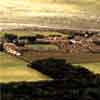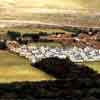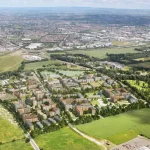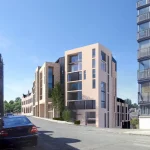Edinburgh & Lothian Structure Plan, Discussion, News
Edinburgh & Lothian Structure Plan, Scotland
Edinburgh, East Lothian, West Lothian, Midlothian Structure Plan
1 Mar 2002
Lothian Structure Plan
Editorial : March 2002
Consultative Draft Edinburgh & Lothian Structure Plan
I was invited to the East Lothian Consultation on Saturday 2nd March. The event involved presentations from six councillors, questions from the floor and then discussion groups.
The title ‘A Sustainable Future for East Lothian?’ at the ‘Sustainable Development Forum’ suggested that positive steps may be afoot. Like organic, this word sustainable seems to mean many things and is ‘oh so popular’ at present. The powerpoint presentations were fairly general but reasonably informative, and the questions afterwards mature and calm. Apparently the East Lothian press have never had as many letters about one subject.
There were four A1-sized maps up on the walls; three identical ones showed East Lothian with pink-hatched areas denoting alternative locations for a proposed New Town, and red-outlined areas for probable town expansion. There were three ‘pink’ areas – Blindwells (former opencast sandmine east of Tranent), Drem and Fenton Barns (adjacent to Drem). Each major town had ‘red’ areas: Dunbar, North Berwick, Haddington, Longniddry and Prestonpans.
The presentations did not really further our knowledge of why these zones had been chosen and how they would be analysed, but dealt with obvious (to me) issues such as roads and schools in very general terms. The statistics however said a lot: Edinburgh & Lothian require 75,200 new homes between 2000 and 2015. These are to be apportioned as follows:-
City of Edinburgh 33,700 (45%)
West Lothian 19,500 (26%)
Midlothian 11,500 (15%)
East Lothian 10,500 (14%)
As Scotland’s population is projected to drop 2% in these years, Edinburgh & Lothian’s is projected to rise by 7% with East Lothian rising by 11%. In terms of sustainability, a major factor is the issue of employment: East Lothian has too few jobs and this situation is projected to worsen: hence any new housing has to be matched by considerable business development.
I feel this is a golden opportunity for people across Edinburgh & Lothian. The new developments – not just housing, but schools, workshops, clinics, etc. – must be of high quality, innovative and confident. Infrastructure must be put in place prior to housing becoming occupied.
The obvious location for a sustainable expansion would be Blindwells (this is currently the Council’s favoured site): why? The area is closest to Edinburgh where many will commute (less pollution, less congestion). The area is currently being cleaned up following years of sand and gravel extraction, hence it could be deemed ‘brownfield’ (like ‘sustainable’ this is a confusing and fashionable term). The area is closest to the sea of any ‘pink’ areas, and effluent would emit onto coast that is not as important to wildlife as say Gullane or Aberlady (though of course it would still effect that coastline).
The publicised problem of a lack of rail link could surely be overcome by creating a station on the mainline that runs right past the site: where there’s a will there’s a way! The age-old difficulties with creating integrated community from scratch (just look at edge-of-town so-called ‘sink’ estates such as Easterhouse and Craigmillar) should not be overlooked.
Incremental development is easiest but here is a pair of examples from the North-East: Banchory tripled in size due to North Sea Oil and lost lots of its charm; divisions between existing industry and incomers led to traditional employment being replaced with commuter homes.
In contrast, Westhills was little more than a hamlet in the early seventies but now exists simply as a new working community, close to Aberdeen thus limiting car journeys. It doesn’t have a rail link and the design quality is low, but that is inconsequential for this contrast: one community strained and was damaged; the other simply exists, and works.
There are many other issues at stake, such as the protection of the greenbelt, economic problems triggered by Edinburgh’s commercial success, empty shops in most town’s High Streets and distance to schools (the ‘school run’). Recent development in Dunbar has been on the outskirts with children having to be driven to School, when empty properties litter the dockside. Villages like Aberlady would lose some of their atmosphere if they doubled in size.
Incremental expansion seems unavoidable: this must be planned so carefully to prevent schools creaking further at the seams; logically this type of expansion must be only allowed where infrastructure can be clearly developed. There’s no point having vast new housing estates when school extensions, etc. are stuck in the planning system.
In summary, the councillors suggested that the green belt would have to be used to some extent and that expansion could not be met by a New Town alone. I suggest that this is a little unimaginative: Scotland has not got many examples of great New Towns (Cumbernauld?), but our councillors should cast there eyes overseas to countries such as Holland and Denmark.
New Towns can work, but these countries would never contemplate estates of Barratt-style houses, dull PFI schools and boxlike clinics. Copenhagen (Kastrup) and The Hague (or Almere), for example, have produced crafted new communities with imaginative design that bring the community together and make them proud.
I propose that we should campaign to highlight the issues in the national Press. In the first instance I will be writing to East Lothian Council, the local MP’s, RFACS (Royal Fine Art Commission for Scotland), CABE (Campaign for the Built Environment), the RIAS (Royal Institute for Architects in Scotland), The Urban Villages Forum (The Princes Foundation), the Urban Forum (UK community umbrella group), Friends of the Earth and other such bodies. I will be doing this through the website and invite other interested parties to write to me. Let’s walk into the future with our eyes open!
Addendum, 18.03.02:
Letters have been sent to all the above organisations requesting input.
Website: The huge rise in total hits for last month has almost been matched, and the highlight was the site being Link of the Week at the popular Vienna Architecture Centre site. Without request the site was added across the globe, most recently on Texas AM University’s website. News also came in from an architect who received approaches from a UK Client via the website.
The main advance for the site in February was of course the Search Tool, purchased using funds made available from the contacts offer: thanks to all those who got involved – they will of course benefit by increased traffic to their sites.
The site continues to develop pages and the /unbuilt, /search engines and /credits pages have been ‘augmented’. Other pages were visually improved and rotating links (javascript) added.
Please mail me if you find a link malfunctioning – recent changes to the contacts pages meant there was a period of transition where some links had to be renewed: this is now complete. An interesting initiative for March will hopefully be an interview with one of Edinburgh’s great architects – now retired – and a key person in Edinburgh’s current development. The site has also been submitted for the Scottish Enterprise Winners@theWeb competition.
News Excerpt re Edinburgh & Lothian Structure Plan:
Strategic Need?
“Villages like Aberlady would totally lose their atmosphere if they doubled in size. The unpopular Cala development already underway in our village will increase the housing stock by 25%, the population by 33% and no. of cars by at least 40%. It will change the character of the village for all time”.


images : Aberlady Conservation Society
Aberlady Homes: Aberlady Conservation Society PR
24.02.03
Dunbar’s speedy expansion to the south seems to be disjointed from the main community and promotes excessive commuting. The expansion of Gullane to the east and Drem to the north-west also seem raw in appearance compared to their respective contexts.
Haddington Amisfield Park site above (Campbell & Arnott Architects’ 1964 estate – Modern Housing – on left background). Other Haddington proposals include the Briery Bank scheme put before the RFACS last year and Letham Mains to the West of the ancient market town:
A proposed housing development at Letham Mains of 450 – 1,000 houses, part of the Edinburgh and Lothians Structure plan, has been given tacit approval by the Haddington and District Amenity Society.
20.02.03
An eleventh-hour bid to slash 800 houses from the total of 4,800 suggested as part of East Lothian Council’s effort to meet future needs, was angrily dismissed.
20.02.03
Ten sites for new housing are likely to be named by East Lothian Council
14.02.03
Scottish Capital Building Designs
Contemporary Scottish Capital Property Designs – recent architectural selection below:
Comments / photos for the Edinburgh & Lothian Structure Plan page welcome




